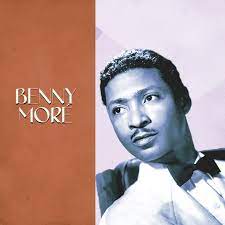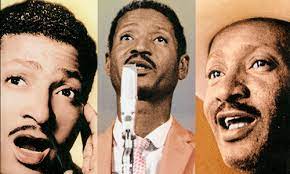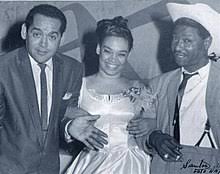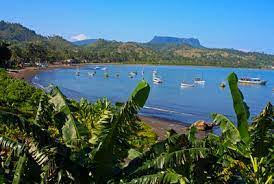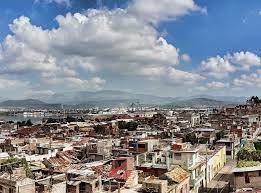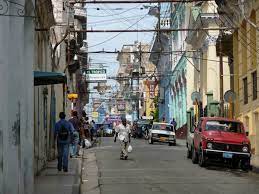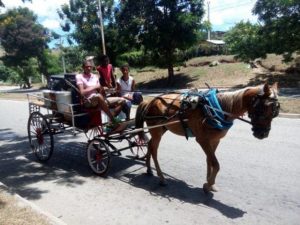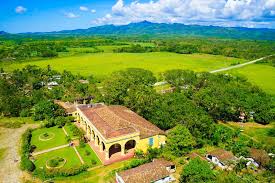BENNY MORÉ “EL BARBARO DEL RITMO”, PARA SIEMPRE EN LA HISTORIA MUSICAL CUBANA. FOTOS. VÍDEOS.
A pesar de habernos dejado para siempre hace muchos años, el recuerdo de su presencia y de su música sigue vigente debido a la brillantez de su trayectoria artística. Cada una de sus interpretaciones sigue vigente en cada cubano, esté donde esté. Benny Moré siempre será su melodía eterna en la historia musical cubana.
Bartolomé Maximiliano Moré Gutiérrez nació el 24 de agosto de 1919, mas conocido solo como el Benny es a menudo considerado como el más grande cantante popular cubano de todos los tiempos. Era musical y tenía una voz de tenor fluida que coloreaba y fraseaba con gran expresividad. Moré fue un maestro de la mayoría de los géneros de la música cubana, como el son montuno, el mambo, la guaracha y el bolero. En particular, es inusual que un cantante sea igualmente competente en ritmos rápidos (por ejemplo, la guaracha) y ritmos más lentos, como el bolero. Moré también formó y dirigió la principal big band cubana de la década de 1950, hasta su muerte en 1963.
En 1936, a los diecisiete años, salió de Las Lajas, donde nació, para La Habana, donde vivía de la venta de frutas y verduras magulladas y dañadas y de hierbas medicinales. Seis meses después regresó a Las Lajas y se fue a cortar caña por una temporada con su hermano Teodoro. Con el dinero que ganó y los ahorros de Teodoro, compró su primera guitarra decente.
VIDEOS- BENNY MORE Y SU BANDA GIGANTE…
CARRERA ARTÍSTICA
Ciro Rodríguez, del afamado Trío Matamoros, escuchó cantar a Moré en el bar El Temple y quedó muy impresionado. Poco tiempo después, en 1942, el Conjunto Matamoros fue contratado para una presentación en vivo para la estación 1010. Sin embargo, Miguel Matamoros se indispuso y le pidió a Mozo Borgellá (director del Septeto Cauto), que le prestara un cantor. Borguellá envió a Moré, quien permaneció varios años con los Matamoros, a realizar una serie de grabaciones.
Moré reemplazó a Miguel Matamoros como cantante principal, y este último se dedicó a dirigir la banda. El 21 de junio de 1945, Moré partió con el Conjunto Matamoros a México, donde actuó en dos de los cabarets más famosos de la época, el Montparnasse y el Río Rosa. Hizo varias grabaciones. El Conjunto Matamoros volvió a La Habana, pero Moré se quedó en México. Rafael Cueto le dijo: “Bien, pero acuérdate que aquí llaman a los burros ‘Bartolo’. Quédate, pero cámbiate el nombre”. “Ok”, respondió Moré, “a partir de ahora mi nombre es Benny, Benny Moré”.
Moré se quedó sin un centavo y obtuvo permiso para trabajar del sindicato de artistas intérpretes o ejecutantes. Con esto pudo conseguir trabajo en el Río Rosa, donde formó el dúo Dueto Fantasma con Lalo Montané.
En la Ciudad de México, Moré grabó para RCA Victor, con Pérez Prado: Bonito y sabroso, Mucho corazón, Pachito el che, La mucura, Rabo y oreja y otros temas. Grabó Dolor Karabalí, que Moré consideró su mejor composición grabada con Pérez Prado, una que nunca quiso volver a grabar, también su grabación en México con la Orquesta de Rafael de Paz de “Bonito y Sabroso” nunca más fue grabada por More, aunque su famosa composición de los meses previos a su salida de México se convirtió con el tiempo en el tema de su big band en Cuba. More siempre se mostró reacio a grabar nuevas versiones de sus éxitos, ya que pensaba que “no se arregla lo que no está roto”. Hubo al menos 22 grabaciones de Moré con la orquesta del Prado.
Moré también grabó con la orquesta de Mariano Mercerón: Me voy pal pueblo y Desdichado”, “Mucho Corazón”, “Ensalada de Mambo”< "Rumberos de Ayer", "Encantado de la Vida", etc. con el Conjunto de Lalo Montane ,cantante, compositor colombiano, con el cual grabó en México formando un famoso dúo llamado "El Dueto Fantasma" o "Dueto Fantasma" También grabó con orquestas mexicanas, especialmente con la dirigida por Rafael de Paz, grabaron Yiri yiri bon, La Culebra, Mata siguaraya, Solamente una vez y Bonito y Sabroso, una canción de mambo donde elogia las habilidades de baile de los mexicanos y afirma que la Ciudad de México y La Habana son ciudades hermanas.
Durante la primavera de 1952, hacia abril, Moré regresa a Cuba. Fue estrella en México, Panamá, Colombia, Brasil y Puerto Rico, pero prácticamente desconocido en la isla. Sus primeras grabaciones cubanas fueron con Mariano Merceron y su Orquesta, temas como "Fiesta de Tambores", "Salomon", "La Chola", etc, etc. Moré empezó a alternar presentaciones en la Cadena Oriental y viajes a La Habana para grabar en el Estudios RCA en CMQ Radiocentro.
En La Habana, Moré trabajó para la emisora RHC Cadena Azul, con la orquesta de Bebo Valdés, quien introdujo el nuevo estilo llamado "batanga". El presentador del programa, Ibraín Urbino, lo presentó como El Bárbaro del Ritmo. Le ofrecieron la oportunidad de grabar con la Sonora Matancera, pero él declinó la oferta porque no le importaba el sonido del grupo.
Después de que las Batanga pasaran de moda, Moré fue contratado por Radio Progreso con la orquesta de Ernesto Duarte Brito. Además de la radio, también actuó en bailes, cabarets y fiestas. Cuando cantó en el Centro Gallego de La Habana, la gente llenó las aceras y los jardines del Capitolio para escucharlo.
En 1952, Moré grabó con la Orquesta Aragón con la que actuaría en salas de baile. La Orquesta Aragón era de Cienfuegos y estaba teniendo problemas para irrumpir en La Habana y Moré los ayudó de esa manera.
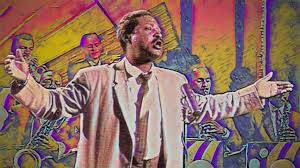
LA BANDA GIGANTE
La primera actuación de la Banda Gigante de Moré fue en el programa Cascabeles Candado de la emisora CMQ. La Banda era generalmente de dieciséis músicos, comparable en tamaño a las orquestas de Xavier Cugat y Pérez Prado. Aunque Moré no podía leer música, arregló el material cantando partes para sus arreglistas.
En los años 1953 y 1955, la Banda Gigante se hizo inmensamente popular. En 1956 y 1957 realizó una gira por Venezuela, Jamaica, Haití, Colombia, Panamá, México y Estados Unidos, donde el grupo tocó en las ceremonias de los Oscar. En La Habana actuó en los salones de baile La Tropical y El Sierra. En 1960 comenzó a actuar tanto de día como de noche.
A Moré le ofrecieron una gira por Europa, Francia en particular, pero la rechazó por miedo a volar (ya había estado en tres accidentes aéreos).
Después de la Revolución Cubana, muchas de las principales figuras musicales de Cuba emigraron, pero Moré se quedó en Cuba, entre, como él dijo, “mi gente” (mi gente).
Moré era alcohólico y comenzó a mostrar signos de insuficiencia hepática a los 40 años. Cuando murió en 1963 de cirrosis hepática, aproximadamente 100.000 fanáticos asistieron a su funeral. Tenía 43 años.
VIDEOS- BENNY MORE CANTA “COMO FUE”..
PREMIOS Y RECONOCIMIENTOS
Una conferencia multimedia del 12 de mayo de 2011 sobre Moré en la comunidad mayoritariamente cubanoamericana de Union City, Nueva Jersey.
El 11 de junio de 2006, Benny Moré fue honrado con una estrella en el Paseo de la Fama en Celia Cruz Park en Union City, Nueva Jersey, una comunidad fuertemente cubanoamericana que ha organizado presentaciones musicales[8] y conferencias multimedia sobre el cantante.
Moré es recordado en la película de 2006, El Benny, que se basa en partes de su vida e incluye nuevas versiones de sus canciones interpretadas por músicos como Chucho Valdés, Juan Formell y Orishas.
También es recordado en libros, como la novela de 2008 de la escritora residente en Miami Daína Chaviano La isla del amor eterno, en la que Moré aparece como uno de los personajes, y el libro de 2009 de University Press of Florida, Wildman of Rhythm: The Life and Music. de Benny Moré, la primera biografía en inglés de Moré.
DISCOGRAFÍA
Canciones seleccionadas
El Inigualable (Discuba, 1957)
The Most From Beny Moré (Victor, 1958; grabado entre 1955 y 1957)
Así es… (Víctor, 1958)
Pare… que llegó el bárbaro (Victor/Discuba, 1958)
Así es… Beny (Discuba, 1958)
La Época de Oro (Víctor, 1958)
Magia antillana (Victor, 1960; grabado 1949 – 1953)
El Barbaro del Ritmo con Pérez Prado y Rafael De Paz (Victor, 1962; grabado 1949 – 1951)
Homenaje póstumo (Discuba, 1963; grabado en 1960)
Benny Moré Y Su Orquesta… (Palma, 1964)
Grabando (RCA Camden, 1964)
Lo Mejor de Beny Moré (RCA, 1965)
La Época De Oro Vol.II (RCA, 1969)
y Su Salsa de Siempre (RCA, 1978)
Grandes Éxitos (Darcole Music, 1979)
Ensalada De Mambo (RCA, 1980)
Lo Último Que Cantó Beny Moré (Integra, 1980)
Lo Desconocido De Beny Moré (RCA, 1982)
Cubanísimo-1 con el Trío Matamoros y la orquesta de Ernesto Duarte (Producciones Preludio, 1983; grabado 1945 – 1947)
Leyendas Musicales (Producciones Preludio, 1986)
Beny Moré Canta Con… (RCA, 1988)
Conjunto Matamoros Con Beny Moré con Conjunto Matamoros (Tumbao Cuban Classics, 1992; grabado 1945 – 1947)
El Barbaro del Ritmo con Pérez Prado (Tumbao Cuban Classics, 1992; grabado 1949 – 1951)
Benny Moré En Vivo (Discmedi, 1995; grabado en 1957)
Benny More Canta Boleros (Estudios EGREM, 2006; grabado 1953 – 1960)
LEGADO
Beny Moré aparece como personaje de la novela La isla del amor eterno (Penguin Random House, 2008), de la escritora cubanoamericana Daína Chaviano, quien también concluye su novela con un capítulo titulado “Hoy como ayer”, una de las mejores interpretaciones de este cantante. Moré también es recordado en la película de 2006, El Benny, que se basa en partes de su vida e incluye nuevas versiones de sus canciones interpretadas por músicos como Chucho Valdés, Juan Formell y Orishas.
Artistas como Tito Puente (1978, 1979 y 1985), Charanga de la 4 (1981), Bobby Carcassés (1985), Tropicana All-Stars (2004) y Jon Secada (2017).
BENNY MORE “EL BARBARO DEL RITMO”, FOREVER IN THE CUBAN MUSICAL HISTORY. PHOTOS. VIDEOS.
Despite having left us forever many years ago, the memory of his presence and his music remains current due to the brilliance of his artistic career. Each of his interpretations is still valid in each Cuban, wherever he is. Benny More will always be his eternal melody in Cuban musical history.
Bartolomé Maximiliano Moré Gutiérrez was born on August 24, 1919, mas conocido solo como el Benny is often thought of as the greatest Cuban popular singer of all time. He was musical and had a fluid tenor voice which he colored and phrased with great expressivity. Moré was a master of most genres of Cuban music, such as the son montuno, mambo, guaracha, and bolero. In particular, it is unusual for a singer to be equally proficient at fast rhythms (e.g. guaracha) and slower rhythms, such as the bolero. Moré also formed and led the leading Cuban big band of the 1950s, until his death in 1963.
In 1936, at age seventeen, he left Las Lajas, where he was born, for Havana, where he lived by selling bruised and damaged fruits and vegetables and medicinal herbs. Six months later he returned to Las Lajas and went to cut cane for a season with his brother Teodoro. With the money he earned and Teodoro’s savings, he bought his first decent guitar.
ARTISTIC CAREER
Ciro Rodríguez, of the famed Trío Matamoros, heard Moré singing in the bar El Temple and was greatly impressed. Shortly thereafter, in 1942, Conjunto Matamoros was engaged for a live performance for station 1010. However, Miguel Matamoros was indisposed and asked Mozo Borgellá (director of Septeto Cauto), to lend him a singer. Borguellá sent Moré, who remained for several years with the Matamoros, to make a number of recordings.
Moré replaced Miguel Matamoros as lead singer, and the latter dedicated himself to leading the band. On June 21, 1945, Moré went with Conjunto Matamoros to Mexico, where he performed in two of the most famous cabarets of the age, the Montparnasse and the Río Rosa. He made several recordings. Conjunto Matamoros returned to Havana, but Moré remained in Mexico. Rafael Cueto said to him: “Fine, but just remember that they call burros “Bartolo” here. Stay, but change your name.” “Ok,” replied Moré, “from now on my name is Benny, Benny Moré.”
Moré was left penniless and got permission to work from the performing artists’ union. With this, he was able to get a job at the Río Rosa, where he formed the duet Dueto Fantasma with Lalo Montané.
In Mexico City, Moré made recordings for RCA Victor, with Perez Prado: Bonito y sabroso, Mucho corazón, Pachito el che, La mucura, Rabo y oreja and other numbers. He recorded Dolor Karabalí, which Moré considered his best composition recorded with Pérez Prado, one he never wanted to re-record, also his recording in Mexico with Rafael de Paz Orchestra of “Bonito y Sabroso” was never recorded again by More, even though his famous composition of the months prior to leaving Mexico became in time the theme of his big band in Cuba. More was always reluctant to record newer versions of his hit songs, as he thought “you don’t fix what’s not broken”. There were at least 22 recordings of Moré with the Prado orchestra.
Moré also recorded with the orchestra of Mariano Mercerón: Me voy pal pueblo y Desdichado”, “Mucho Corazon”,”Ensalada de Mambo”< "Rumberos de Ayer", "Encantado de la Vida", etc. with the Conjunto de Lalo Montane,a Colombian singer, composer, with which he recorded in Mexico forming a famous duo called "The Phantom Duet" or "Dueto Fantasma" . He also recorded with Mexican orchestras, especially with the one directed by Rafael de Paz; they recorded Yiri yiri bon, La Culebra, Mata siguaraya, Solamente una vez and Bonito y Sabroso, a mambo song where he praises the dancing skills of the Mexicans, and claims that Mexico City and La Habana are sister cities.
During the spring of 1952, around April, Moré returned to Cuba. He was a star in Mexico, Panama, Colombia, Brazil, and Puerto Rico, but virtually unknown on the island. His first Cuban recordings were with Mariano Merceron & his Orchestra, songs like "Fiesta de Tambores", "Salomon", "La Chola", etc, etc. Moré began alternating between performances in the Cadena Oriental and trips to Havana to record at the RCA studios in CMQ Radiocentro.
In Havana, Moré worked for the radio station RHC Cadena Azul, with the orchestra of Bebo Valdés, who introduced the new style called "batanga". The presenter of the show, Ibraín Urbino, presented him as El Bárbaro del Ritmo. They offered him the opportunity to record with Sonora Matancera, but he declined the offer because he didn't care for the sound of the group.
After the Batangas fell out of fashion, Moré was contracted by Radio Progreso with the orchestra of Ernesto Duarte Brito. In addition to the radio, he also performed at dances, cabarets, and parties. When he sang in Havana's Centro Gallego, people filled the sidewalks and the gardens of the Capitolio to hear him.
In 1952, Moré made a recording with the Orquesta Aragón with whom he would perform in dance halls. Orquesta Aragón was from Cienfuegos and was having trouble breaking into Havana and Moré helped them in this way.
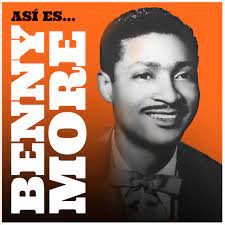
LA BANDA GIGANTE
The first performance of Moré’s Banda Gigante (Big Band) was in the program Cascabeles Candado of the station CMQ. The Banda was generally sixteen musicians, comparable in size to the orchestras of Xavier Cugat and Pérez Prado. Although Moré could not read music, he arranged material by singing parts to his arrangers.
In the years 1953 and 1955, the Banda Gigante became immensely popular. In 1956 and 1957, it toured Venezuela, Jamaica, Haiti, Colombia, Panama, Mexico, and the United States, where the group played at the Oscar ceremonies. In Havana, it played at the dance halls La Tropical and El Sierra. In 1960, it started performing both night and day.
Moré was offered a tour of Europe – France in particular – but he rejected it because of fear of flying (he had by that time been in three air accidents).
In the aftermath of the Cuban Revolution, many of Cuba’s top musical figures emigrated, but Moré stayed in Cuba, among, as he said, “mi gente” (my people).
Moré was an alcoholic and began to show signs of liver failure in his early 40s. When he died in 1963 of cirrhosis of the liver, an estimated 100,000 fans attended his funeral. He was 43 years old.
AWARDS AND RECOGNITION
A May 12, 2011 multimedia lecture on Moré in the heavily Cuban-American community of Union City, New Jersey.
On June 11, 2006, Benny Moré was honored with a star on the Walk of Fame at Celia Cruz Park in Union City, New Jersey, a heavily Cuban-American community that has hosted musical presentations[8] and multimedia lectures on the singer.
Moré is remembered in the 2006 film, El Benny, which is based on parts of his life, and includes new versions of his songs performed by musicians including Chucho Valdés, Juan Formell, and Orishas.
He is also remembered in books, such as Miami-based writer Daína Chaviano’s 2008 novel The Island of Eternal Love, in which Moré appears as one of the characters, and the University Press of Florida’s 2009 book, Wildman of Rhythm: The Life and Music of Benny Moré, the first English language biography of Moré.
DISCOGRAPHY
Selected songs
El Inigualable (Discuba, 1957)
The Most From Beny Moré (Victor, 1958; recorded 1955 – 1957)
Así es… (Victor, 1958)
Pare… que llegó el bárbaro (Victor/Discuba, 1958)
Así es… Beny (Discuba, 1958)
La Época de Oro (Victor, 1958)
Magia antillana (Victor, 1960; recorded 1949 – 1953)
El Barbaro del Ritmo with Perez Prado and Rafael De Paz (Victor, 1962; recorded 1949 – 1951)
Homenaje póstumo (Discuba, 1963; recorded 1960)
Benny More Y Su Orquesta… (Palma, 1964)
Recordando (RCA Camden, 1964)
Lo Mejor de Beny Moré (RCA, 1965)
La Época De Oro Vol.II (RCA, 1969)
y Su Salsa de Siempre (RCA, 1978)
Grandes Exitos (Darcole Music, 1979)
Ensalada De Mambo (RCA, 1980)
Lo Último Que Cantó Beny More (Integra, 1980)
Lo Desconocido De Beny More (RCA, 1982)
Cubanísimo-1 with Trío Matamoros and Ernesto Duarte’s orchestra (Producciones Preludio, 1983; recorded 1945 – 1947)
Leyendas Musicales (Producciones Preludio, 1986)
Beny Moré Canta Con… (RCA, 1988)
Conjunto Matamoros With Beny Moré with Conjunto Matamoros (Tumbao Cuban Classics, 1992; recorded 1945 – 1947)
El Barbaro del Ritmo with Perez Prado (Tumbao Cuban Classics, 1992; recorded 1949 – 1951)
Benny Moré En Vivo (Discmedi, 1995; recorded 1957)
Benny More Canta Boleros (Estudios EGREM, 2006; recorded 1953 – 1960)
LEGACY
Beny Moré appears as a character in the novel The Island of Eternal Love (Penguin Random House, 2008), by Cuban-American writer Daína Chaviano, who also concludes her novel with a chapter entitled “Today as Yesterday”, one of the best interpretations of this singer. Moré is also remembered in the 2006 film, El Benny, which is based on parts of his life, and includes new versions of his songs performed by musicians including Chucho Valdés, Juan Formell, and Orishas.
Numerous tribute albums consisting of cover versions of Moré’s songs have been released by artists such as Tito Puente (1978, 1979, and 1985), Charanga de la 4 (1981), Bobby Carcassés (1985), Tropicana All-Stars (2004) and Jon Secada (2017).
Agencies/ Wiki/ BennyMoreBio./ Extractos/ Excerpts/ Internet Photos/ YouTube/ Arnoldo Varona/ www.TheCubanHistory.com
THE CUBAN HISTORY, HOLLYWOOD.



